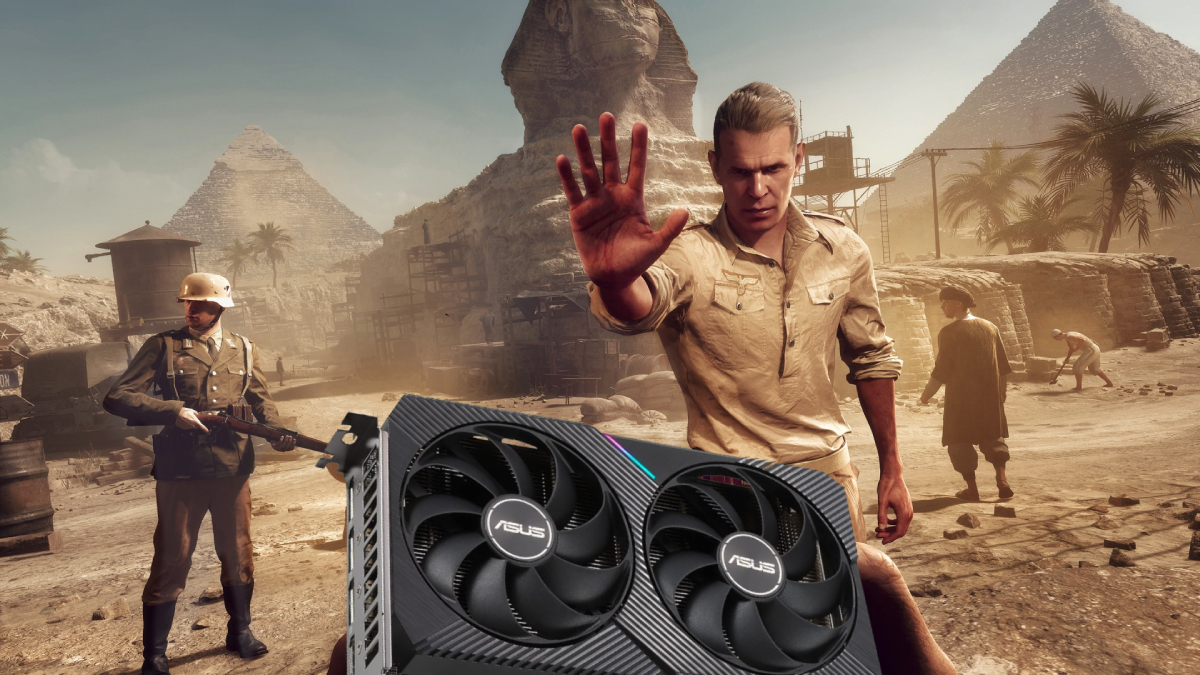RTX 3060 performs better at native 1080p than RTX 4060 in the new Indiana Jones game and it’s clear why

Table of Contents
It’s clear that Indiana Jones and the Great Circle system requirements weren’t joking – the game is difficult to run. This has been immediately evident on mid-range GPUs, especially those with lower amounts of VRAM. It is fairly safe to say that 8GB of VRAM isn’t good enough if you want super smooth performance (especially with higher texture settings) and the devs have already put out a patch to try and address it.
When putting together the best settings for the game, even our RTX 3090 (paired with the 7800X3D) was struggling on high settings at 4K, so we opted for 1440p. And now, new benchmarks posted online show that the 12GB RTX 3060 is outperforming the newer RTX 4060 in rasterization, which Nvidia cut down to just 8GB of VRAM.
RTX 3060 (12GB) performs better than RTX 4060 (8GB) in these native 1080p benchmarks
Thanks to new benchmarks published by German outlet PC Games Hardware (PCGH), we can see how well the game performs at full HD (1080p) max settings. According to the test, the RTX 4060 averaged just 25.2 FPS with 1% lows of 18, while the last-gen RTX 3060 enjoyed an average of 57 and 1% lows of 51.
This means the 3060 offers more than double the performance of the GPU that was supposed to replace it, and it’s evident that its 12GB of VRAM makes a notable difference; similar differences can be spotted between the RX 7600 (8GB) and RX 7600 XT (16GB).
Do keep in mind that this is without upscaling or frame generation, the latter of which the 4060 makes full use of as DLSS 3 Frame Gen is exclusive to the 40-series currently. In any case, we think frame gen shouldn’t exist to reach 60 FPS, though the 4060 can still perform well at native when the texture settings are cranked down – this is the main culprit for high VRAM usage deflating the performance of the 8GB cards.

When the RTX 4060 was released, the generational performance lift was relatively disappointing. In our RTX 4060 review, we complemented its 1080p performance and the potential of DLSS 3 Frame Generation, but when it comes to pure rasterization, the 40-series card isn’t much of an upgrade to the 3060.
Looking at the specs of the two cards, we can see that efficiency was the name of the game for Nvidia with the 4060. Sadly, that meant stripping back the memory and that’s had a significant effect on Indiana Jones and the Great Circle, which is (evidently) hungry for memory. However, it is clear that high texture settings are the main source of the problem as we’ll demonstrate in further benchmarks down below.
| Specification | RTX 4060 | RTX 3060 |
|---|---|---|
| Architecture | Ada Lovelace | Ampere |
| Base clock | 1,830 MHz | 1,320 MHz |
| Boost clock | 2,460 MHz | 1,777 MHz |
| Memory clock | 17 Gbps | 15 Gbps |
| VRAM | 8GB GDDR6 | 12GB GDDR6 |
| Memory bus | 128-bit | 192-bit |
| Memory bandwidth | 272.0 GB/s | 360.0 GB/s |
| CUDA cores | 3,072 | 3,584 |
| Bus interface | PCIe 4.0 x8 | PCIe 4.0 x16 |
| TDP | 115 W | 170 W |
RTX 4060 does shine with lower texture settings, plus DLSS 3 makes a big difference
It’s no secret that one of the biggest selling points of the RTX 4060, and the 40-series as a whole, is exclusive access to DLSS 3 Frame Generation. Indiana Jones and the Great Circle is a title with full DLSS 3 support at launch, including full ray tracing (path tracing) exclusive to Nvidia cards with 12GB VRAM or above. So, you won’t be utilizing path tracing with the 4060, but you can still enjoy solid performance.
Benchmark videos such as the one below from Geralt Benchmarks showcase what the RTX 4060 is capable of when you harness the power of Nvidia’s AI upscaling tech. They suggest using a custom preset due to high VRAM usage, with medium textures recommended as a maximum. With tweaks like this, the 4060 enjoyed an average of 81 FPS at native 1080p with custom ultra settings; this is boosted up to a 105 average with DLSS 3 quality mode enabled. 1440p is also achievable with the right settings.
Benchmarks released for the RTX 3060 also demonstrate that the card can perform well; the extra 4GB of VRAM continues to help drive solid performance with some of the higher texture settings as well, while the 4060 is better off lowering them.
What GPU would we suggest?
If you were to take a look at our best GPUs for Indiana Jones and the Great Circle, you’ll notice that the RTX 4090 is our top pick. It’s the most powerful GPU on the market right now and the 24GB of VRAM is unmatched; AMD’s 7900 XTX with 20GB comes in second. However, if we’re looking around the price point of the RTX 4060 at ~$300, Intel’s upcoming Arc B580 looks like a promising choice – or the RX 6750 XT from Team Red. Both of these cards feature 12GB memory and should outperform the 4060 in Indiana Jones and the Great Circle, at least in rasterization.
As we said, the RTX 4060 can still hold its own when utilizing the full feature suite that DLSS 3 offers, but there is an overwhelming feeling that 8GB cards are slowly becoming outdated as more demanding AAA titles are released. It’s worth noting that the game will eventually receive FSR support, though it is not known whether this will include FSR 3 Frame Gen or not.
XFX Speedster QICK 319 RX 6750 XT

